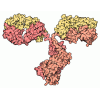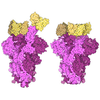+ Open data
Open data
- Basic information
Basic information
| Entry | Database: PDB / ID: 9q9s | |||||||||||||||
|---|---|---|---|---|---|---|---|---|---|---|---|---|---|---|---|---|
| Title | HSV-2 prefusion glycoprotein B bound by Nb1_gbHSV | |||||||||||||||
 Components Components |
| |||||||||||||||
 Keywords Keywords | VIRAL PROTEIN / viral membrane fusion protein / glycoprotein B / Herpes simplex virus 2 / nanobody complex | |||||||||||||||
| Function / homology |  Function and homology information Function and homology informationhost cell Golgi membrane / host cell endosome membrane / viral envelope / symbiont entry into host cell / virion attachment to host cell / host cell plasma membrane / virion membrane / membrane Similarity search - Function | |||||||||||||||
| Biological species |   Human herpesvirus 2 strain 333 Human herpesvirus 2 strain 333 | |||||||||||||||
| Method | ELECTRON MICROSCOPY / single particle reconstruction / cryo EM / Resolution: 2.7 Å | |||||||||||||||
 Authors Authors | Vollmer, B. / Mulvaney, T. / Ebel, H. / Nentwig, J. / Gruenewald, K. | |||||||||||||||
| Funding support |  Germany, Germany,  United Kingdom, 4items United Kingdom, 4items
| |||||||||||||||
 Citation Citation |  Journal: Nature / Year: 2025 Journal: Nature / Year: 2025Title: A nanobody specific to prefusion glycoprotein B neutralizes HSV-1 and HSV-2. Authors: Benjamin Vollmer / Henriette Ebel / Renate Rees / Julia Nentwig / Thomas Mulvaney / Jürgen Schünemann / Jens Krull / Maya Topf / Dirk Görlich / Kay Grünewald /  Abstract: The nine human herpesviruses, including herpes simplex virus 1 and 2, human cytomegalovirus and Epstein-Barr virus, present a significant burden to global public health. Their envelopes contain at ...The nine human herpesviruses, including herpes simplex virus 1 and 2, human cytomegalovirus and Epstein-Barr virus, present a significant burden to global public health. Their envelopes contain at least ten different glycoproteins, which are necessary for host cell tropism, attachment and entry. The best conserved among them, glycoprotein B (gB), is essential as it performs membrane fusion by undergoing extensive rearrangements from a prefusion to postfusion conformation. At present, there are no antiviral drugs targeting gB or neutralizing antibodies directed against its prefusion form, because of the difficulty in structurally determining and using this metastable conformation. Here we show the isolation of prefusion-specific nanobodies, one of which exhibits strong neutralizing and cross-species activity. By mutational stabilization we solved the herpes simplex virus 1 gB full-length prefusion structure, which allowed the bound epitope to be determined. Our analyses show the membrane-embedded regions of gB and previously unresolved structural features, including a new fusion loop arrangement, providing insights into the initial conformational changes required for membrane fusion. Binding an epitope spanning three domains, proximal only in the prefusion state, the nanobody keeps wild-type HSV-2 gB in this conformation and enabled its native prefusion structure to be determined. This also indicates the mode of neutralization and an attractive avenue for antiviral interventions. | |||||||||||||||
| History |
|
- Structure visualization
Structure visualization
| Structure viewer | Molecule:  Molmil Molmil Jmol/JSmol Jmol/JSmol |
|---|
- Downloads & links
Downloads & links
- Download
Download
| PDBx/mmCIF format |  9q9s.cif.gz 9q9s.cif.gz | 389.2 KB | Display |  PDBx/mmCIF format PDBx/mmCIF format |
|---|---|---|---|---|
| PDB format |  pdb9q9s.ent.gz pdb9q9s.ent.gz | 300.8 KB | Display |  PDB format PDB format |
| PDBx/mmJSON format |  9q9s.json.gz 9q9s.json.gz | Tree view |  PDBx/mmJSON format PDBx/mmJSON format | |
| Others |  Other downloads Other downloads |
-Validation report
| Summary document |  9q9s_validation.pdf.gz 9q9s_validation.pdf.gz | 2.2 MB | Display |  wwPDB validaton report wwPDB validaton report |
|---|---|---|---|---|
| Full document |  9q9s_full_validation.pdf.gz 9q9s_full_validation.pdf.gz | 2.2 MB | Display | |
| Data in XML |  9q9s_validation.xml.gz 9q9s_validation.xml.gz | 67.7 KB | Display | |
| Data in CIF |  9q9s_validation.cif.gz 9q9s_validation.cif.gz | 103.2 KB | Display | |
| Arichive directory |  https://data.pdbj.org/pub/pdb/validation_reports/q9/9q9s https://data.pdbj.org/pub/pdb/validation_reports/q9/9q9s ftp://data.pdbj.org/pub/pdb/validation_reports/q9/9q9s ftp://data.pdbj.org/pub/pdb/validation_reports/q9/9q9s | HTTPS FTP |
-Related structure data
| Related structure data |  52966MC  9ih8C  9q9lC  9q9nC C: citing same article ( M: map data used to model this data |
|---|---|
| Similar structure data | Similarity search - Function & homology  F&H Search F&H Search |
- Links
Links
- Assembly
Assembly
| Deposited unit | 
|
|---|---|
| 1 |
|
- Components
Components
| #1: Antibody | Mass: 12821.279 Da / Num. of mol.: 3 Source method: isolated from a genetically manipulated source Source: (gene. exp.)   #2: Protein | Mass: 104648.422 Da / Num. of mol.: 3 Source method: isolated from a genetically manipulated source Details: C-terminal HRV 3C + Strep Tag II / Source: (gene. exp.)  Human herpesvirus 2 strain 333 / Gene: gB, UL27 / Plasmid: pHR-CAG / Details (production host): lentiviral transduction / Cell line (production host): HEK-293T / Organ (production host): KIDNEY / Production host: Human herpesvirus 2 strain 333 / Gene: gB, UL27 / Plasmid: pHR-CAG / Details (production host): lentiviral transduction / Cell line (production host): HEK-293T / Organ (production host): KIDNEY / Production host:  Homo sapiens (human) / References: UniProt: P06763 Homo sapiens (human) / References: UniProt: P06763#3: Polysaccharide | 2-acetamido-2-deoxy-beta-D-glucopyranose-(1-4)-2-acetamido-2-deoxy-beta-D-glucopyranose Source method: isolated from a genetically manipulated source Has ligand of interest | N | Has protein modification | Y | |
|---|
-Experimental details
-Experiment
| Experiment | Method: ELECTRON MICROSCOPY |
|---|---|
| EM experiment | Aggregation state: PARTICLE / 3D reconstruction method: single particle reconstruction |
- Sample preparation
Sample preparation
| Component |
| ||||||||||||||||||||||||||||
|---|---|---|---|---|---|---|---|---|---|---|---|---|---|---|---|---|---|---|---|---|---|---|---|---|---|---|---|---|---|
| Source (natural) |
| ||||||||||||||||||||||||||||
| Source (recombinant) |
| ||||||||||||||||||||||||||||
| Buffer solution | pH: 7.8 | ||||||||||||||||||||||||||||
| Buffer component |
| ||||||||||||||||||||||||||||
| Specimen | Conc.: 0.1 mg/ml / Embedding applied: NO / Shadowing applied: NO / Staining applied: NO / Vitrification applied: YES | ||||||||||||||||||||||||||||
| Specimen support | Details: grid was overlayed with 2 nm carbon / Grid material: COPPER / Grid mesh size: 400 divisions/in. / Grid type: Quantifoil R2/1 | ||||||||||||||||||||||||||||
| Vitrification | Instrument: FEI VITROBOT MARK IV / Cryogen name: ETHANE-PROPANE / Humidity: 80 % / Chamber temperature: 277.15 K |
- Electron microscopy imaging
Electron microscopy imaging
| Experimental equipment |  Model: Titan Krios / Image courtesy: FEI Company |
|---|---|
| Microscopy | Model: TFS KRIOS |
| Electron gun | Electron source:  FIELD EMISSION GUN / Accelerating voltage: 300 kV / Illumination mode: FLOOD BEAM FIELD EMISSION GUN / Accelerating voltage: 300 kV / Illumination mode: FLOOD BEAM |
| Electron lens | Mode: BRIGHT FIELD / Nominal magnification: 105000 X / Nominal defocus max: 3000 nm / Nominal defocus min: 500 nm / Cs: 2.7 mm / C2 aperture diameter: 70 µm / Alignment procedure: COMA FREE |
| Specimen holder | Cryogen: NITROGEN / Specimen holder model: FEI TITAN KRIOS AUTOGRID HOLDER |
| Image recording | Average exposure time: 2.2 sec. / Electron dose: 43.84 e/Å2 / Film or detector model: GATAN K3 BIOQUANTUM (6k x 4k) / Num. of grids imaged: 1 / Num. of real images: 14886 |
| Image scans | Width: 5760 / Height: 4092 |
- Processing
Processing
| EM software |
| ||||||||||||||||||||||||||||||||||||||||||||||||||||||||||||
|---|---|---|---|---|---|---|---|---|---|---|---|---|---|---|---|---|---|---|---|---|---|---|---|---|---|---|---|---|---|---|---|---|---|---|---|---|---|---|---|---|---|---|---|---|---|---|---|---|---|---|---|---|---|---|---|---|---|---|---|---|---|
| CTF correction | Type: PHASE FLIPPING AND AMPLITUDE CORRECTION | ||||||||||||||||||||||||||||||||||||||||||||||||||||||||||||
| Particle selection | Num. of particles selected: 3901343 | ||||||||||||||||||||||||||||||||||||||||||||||||||||||||||||
| Symmetry | Point symmetry: C3 (3 fold cyclic) | ||||||||||||||||||||||||||||||||||||||||||||||||||||||||||||
| 3D reconstruction | Resolution: 2.7 Å / Resolution method: FSC 0.143 CUT-OFF / Num. of particles: 158509 / Algorithm: BACK PROJECTION / Symmetry type: POINT | ||||||||||||||||||||||||||||||||||||||||||||||||||||||||||||
| Atomic model building | B value: 44.04 / Protocol: AB INITIO MODEL / Space: REAL | ||||||||||||||||||||||||||||||||||||||||||||||||||||||||||||
| Atomic model building | Details: ModelAngelo / Source name: Other / Type: experimental model |
 Movie
Movie Controller
Controller






 PDBj
PDBj

